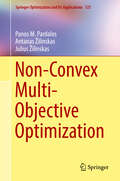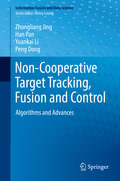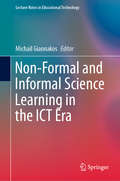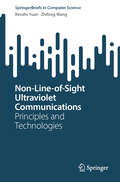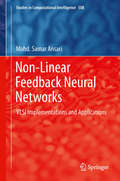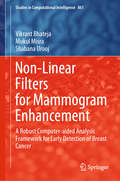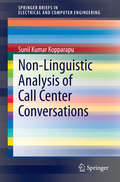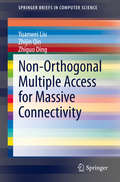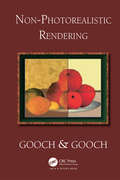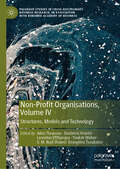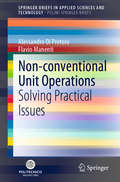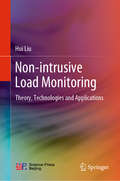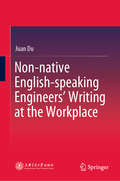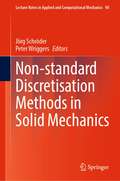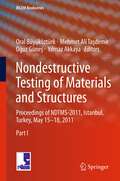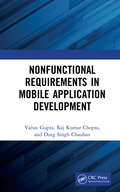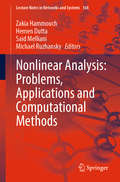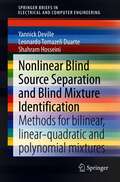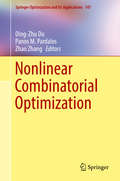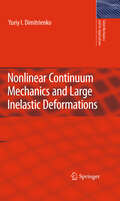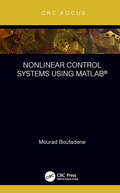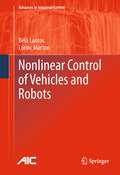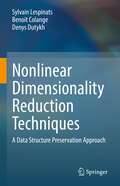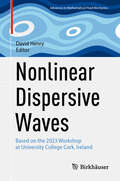- Table View
- List View
Non-Convex Multi-Objective Optimization (Springer Optimization and Its Applications #123)
by Panos M. Pardalos Julius Žilinskas Antanas ŽilinskasRecent results on non-convex multi-objective optimization problems and methods are presented in this book, with particular attention to expensive black-box objective functions. Multi-objective optimization methods facilitate designers, engineers, and researchers to make decisions on appropriate trade-offs between various conflicting goals. A variety of deterministic and stochastic multi-objective optimization methods are developed in this book. Beginning with basic concepts and a review of non-convex single-objective optimization problems; this book moves on to cover multi-objective branch and bound algorithms, worst-case optimal algorithms (for Lipschitz functions and bi-objective problems), statistical models based algorithms, and probabilistic branch and bound approach. Detailed descriptions of new algorithms for non-convex multi-objective optimization, their theoretical substantiation, and examples for practical applications to the cell formation problem in manufacturing engineering, the process design in chemical engineering, and business process management are included to aide researchers and graduate students in mathematics, computer science, engineering, economics, and business management.
Non-Cooperative Target Tracking, Fusion and Control: Algorithms and Advances (Information Fusion and Data Science)
by Zhongliang Jing Han Pan Yuankai Li Peng DongThis book gives a concise and comprehensive overview of non-cooperative target tracking, fusion and control. Focusing on algorithms rather than theories for non-cooperative targets including air and space-borne targets, this work explores a number of advanced techniques, including Gaussian mixture cardinalized probability hypothesis density (CPHD) filter, optimization on manifold, construction of filter banks and tight frames, structured sparse representation, and others. Containing a variety of illustrative and computational examples, Non-cooperative Target Tracking, Fusion and Control will be useful for students as well as engineers with an interest in information fusion, aerospace applications, radar data processing and remote sensing.
Non-Formal and Informal Science Learning in the ICT Era (Lecture Notes in Educational Technology)
by Michail GiannakosThis book introduces the reader to evidence-based non-formal and informal science learning considerations (including technological and pedagogical innovations) that have emerged in and empowered the information and communications technology (ICT) era. The contributions come from diverse countries and contexts (such as hackerspaces, museums, makerspaces, after-school activities) to support a wide range of educators, practitioners, and researchers (such as K-12 teachers, learning scientists, museum curators, librarians, parents, hobbyists). The documented considerations, lessons learned, and concepts have been extracted using diverse methods, ranging from experience reports and conceptual methods to quantitative studies and field observation using qualitative methods. This volume attempts to support the preparation, set-up, implementation, but also evaluation of informal learning activities to enhance science education.
Non-Line-of-Sight Ultraviolet Communications: Principles and Technologies (SpringerBriefs in Computer Science)
by Renzhi Yuan Zhifeng WangThis book provides a comprehensive review and the latest progress of ultraviolet communications. Optical wireless communications employing electromagnetic waves in optical wavebands as information carriers can achieve higher communication bandwidth compared with radio frequency based wireless communication. However, the good directionality of optical waves degrades its non-line-of-sight transmission ability for avoiding obstacles. The ultraviolet communication employs the ultraviolet light in “solar blind” waveband (200–280 nm) as information carriers. The name “solar blind" is derived from the fact that the solar radiation in 200–280 nm is strongly absorbed by the ozone layer of the atmosphere such that little ultraviolet lights can reach the earth's surface. Therefore, ultraviolet communications enjoy low background radiation noise compared with other optical wireless communications. Besides, the strong absorption effect of ultraviolet lights in the atmosphere also guarantees a good local security due to the verified low-probability-of-detection. Therefore, the ultraviolet communication becomes a promising non-line-of-sight optical wireless communication technology and attracted increasing research attentions in recent decades. This book mainly focuses on the key principles and technologies of ultraviolet communications, including the channel modeling, achievable information rate, full-duplex ultraviolet communication, relay-assisted ultraviolet communication, non-line-of-sight ultraviolet positioning, and some future prospects of ultraviolet communications.
Non-Linear Feedback Neural Networks: VLSI Implementations and Applications
by Mohd. Samar AnsariThis book aims to present a viable alternative to the Hopfield Neural Network (HNN) model for analog computation. It is well known the standard HNN suffers from problems of convergence to local minima, and requirement of a large number of neurons and synaptic weights. Therefore, improved solutions are needed. The non-linear synapse neural network (NoSyNN) is one such possibility and is discussed in detail in this book. This book also discusses the applications in computationally intensive tasks like graph coloring, ranking, and linear as well as quadratic programming. The material in the book is useful to students, researchers and academician working in the area of analog computation.
Non-Linear Filters for Mammogram Enhancement: A Robust Computer-aided Analysis Framework for Early Detection of Breast Cancer (Studies in Computational Intelligence #861)
by Vikrant Bhateja Shabana Urooj Mukul MisraThis book presents non-linear image enhancement approaches to mammograms as a robust computer-aided analysis solution for the early detection of breast cancer, and provides a compendium of non-linear mammogram enhancement approaches: from the fundamentals to research challenges, practical implementations, validation, and advances in applications.The book includes a comprehensive discussion on breast cancer, mammography, breast anomalies, and computer-aided analysis of mammograms. It also addresses fundamental concepts of mammogram enhancement and associated challenges, and features a detailed review of various state-of-the-art approaches to the enhancement of mammographic images and emerging research gaps. Given its scope, the book offers a valuable asset for radiologists and medical experts (oncologists), as mammogram visualization can enhance the precision of their diagnostic analyses; and for researchers and engineers, as the analysis of non-linear filters is one of the most challenging research domains in image processing.
Non-Linguistic Analysis of Call Center Conversations
by Sunil Kumar KopparapuThe book focuses on the part of the audio conversation not related to language such as speaking rate (in terms of number of syllables per unit time) and emotion centric features. This text examines using non-linguistics features to infer information from phone calls to call centers. The author analyzes "how" the conversation happens and not "what" the conversation is about by audio signal processing and analysis.
Non-Orthogonal Multiple Access for Massive Connectivity (SpringerBriefs in Computer Science)
by Zhiguo Ding Zhijin Qin Yuanwei LiuThis book discusses non-orthogonal multiple access (NOMA) and the various issues in NOMA networks, including capability, sustainability, and security. This book starts from the basics and key techniques of NOMA. Subsequently, the authors discuss three critical issues in NOMA networks, including compatibility, sustainability, and security. Particularly, the authors first demonstrate the applications of NOMA in different networks including MIMO-NOMA, NOMA in heterogeneous networks, and NOMA in cognitive radio networks to show the compatibility of NOMA with various networks. Then the wireless powered NOMA networks are presented to address the sustainability issues in NOMA networks to extend the network reliability and lifetime. The security enhanced NOMA networks are discussed for single antenna case and multiple antenna case, respectively. Finally, the most recent developments on artificial intelligence (AI) enabled NOMA networks are discussed and the research challenges on NOMA to support massive number of devices are identified.
Non-Photorealistic Rendering
by Bruce Gooch Amy GoochThe ubiquity of computer-generated imagery around us, in movies, advertising or on the Internet is already being taken for granted and what impresses most people is the photorealistic quality of the images. Pictures, as we have often been told, are worth a thousand words and the information transported by an image can take many different forms. Man
Non-Profit Organisations, Volume IV: Structures, Models and Technology (Palgrave Studies in Cross-disciplinary Business Research, In Association with EuroMed Academy of Business)
by Leonidas Efthymiou Demetris Vrontis Yaakov Weber Alkis Thrassou Evangelos Tsoukatos S. M. Riad ShamsThis four-volume book examines, through multiple and cross-discipline perspectives, the science and practice of not-for-profit organisations. These organisations have drawn considerable attention and witnessed extensive growth as they engage in delivering public services to society. And are increasingly pressured to balance business with social goals, inherent idiosyncratic features with management creativity, structural limitations with operational flexibility, and ethical boundaries with pragmatism; all with scarce resources but abundant determination. The first volume explores the opportunities and challenges of non-profit organisations in the contemporary environment, elucidating current and future issues in the field, setting strategic directions, and presenting sector-wide examples and best practices. The second volume explores contextual aspects relating to the economy and industries. The third volume presents social and ethical aspects, as well as matters of sustainability, accountability and the overall wellbeing of society. The fourth and final volume examines structures and models, with an emphasis on technology.
Non-conventional Unit Operations: Solving Practical Issues (SpringerBriefs in Applied Sciences and Technology)
by Flavio Manenti Alessandro Di PretoroThis volume presents both methodologies and numerical applications for the design of non-conventional unit operations in chemical processes and plants, which are rarely studied in depth at an academic level but have wide applications in the industrial sector. The first part discusses the design, comparison and optimization of heating and cooling operations that are different from simple heat exchange. The second and larger part offers a brief but effective overview of non-conventional separation processes, mainly focusing on the heterogeneous phases. Based on sample case studies, it extrapolates the process model equations and includes the numerical solution in order to provide a straightforward application example. The end of each chapter features a C++ code implementation to solve the ODE or nonlinear equations system using the BzzMath library.
Non-intrusive Load Monitoring: Theory, Technologies and Applications
by Hui LiuFocusing on non-intrusive load monitoring techniques in the area of smart grids and smart buildings, this book presents a thorough introduction to related basic principles, while also proposing improvements. As the basis of demand-side energy management, the non-intrusive load monitoring techniques are highly promising in terms of their energy-saving and carbon emission reduction potential.The book is structured clearly and written concisely. It introduces each aspect of these techniques with a number of examples, helping readers to understand and use the corresponding results. It provides latest strengths on the non-intrusive load monitoring techniques for engineers and managers of relevant departments. It also offers extensive information and a source of inspiration for researchers and students, while outlining future research directions.
Non-native English-speaking Engineers’ Writing at the Workplace
by Juan DuBased on 55 semi-structured in-depth interviews, this book investigates 15 high-tech engineering co-op professionals’ writing experience in the workplace. It shows how the digital age has had a marked impact on the engineers’ methods of communication at work, and how on-the -job writing has affected engineers’ technical competence, shaped their professional identities, challenged their views on Chinese and English writing, and hindered their success in the workplace. The book identifies three aspects of writing practice: engineers’ linguistic and literacy challenges, the reasons behind these challenges, and coping strategies, which suggest that engineers are underprepared and lack necessary support in the workplace. Lastly, the study shows that engineers need to engage in technical literacy through on-the-job writing so that they can fully deal with workplace discourse and socialize with diverse professional groups.Since the sample group interviewed in this book is engineers who studied at universities in the United States and have a foot in the world of school and work as well as knowledge of both Eastern and Western cultures, the book appeals to teachers, students, engineers and scientists who are interested in scientific and technological writing. It is also valuable for educators who prepare scientists, engineers, and technical communicators for professional roles, as well as for communication practitioners who work with engineers.
Non-standard Discretisation Methods in Solid Mechanics (Lecture Notes in Applied and Computational Mechanics #98)
by Peter Wriggers Jörg SchröderThis edited volume summarizes research being pursued within the DFG Priority Programme 1748: "Reliable Simulation Methods in Solid Mechanics. Development of non-standard discretisation methods, mechanical and mathematical analysis", the aim of which was to develop novel discretisation methods based e.g. on mixed finite element methods, isogeometric approaches as well as discontinuous Galerkin formulations, including a sound mathematical analysis for geometrically as well as physically nonlinear problems. The Priority Programme has established an international framework for mechanical and applied mathematical research to pursue open challenges on an inter-disciplinary level. The compiled results can be understood as state of the art in the research field and show promising ways of further research in the respective areas. The book is intended for doctoral and post-doctoral students in civil engineering, mechanical engineering, applied mathematics and physics, as well as industrial researchers interested in the field.
Nondestructive Testing of Materials and Structures
by Mehmet Ali Taşdemir Oral Büyüköztürk Oğuz Güneş Yılmaz AkkayaCondition assessment and characterization of materials and structures by means of nondestructive testing (NDT) methods is a priority need around the world to meet the challenges associated with the durability, maintenance, rehabilitation, retrofitting, renewal and health monitoring of new and existing infrastructures including historic monuments. Numerous NDT methods that make use of certain components of the electromagnetic and acoustic spectrum are currently in use to this effect with various levels of success and there is an intensive worldwide research effort aimed at improving the existing methods and developing new ones. The knowledge and information compiled in this book captures the current state of the art in NDT methods and their application to civil and other engineering materials and structures. Critical reviews and advanced interdisciplinary discussions by world-renowned researchers point to the capabilities and limitations of the currently used NDT methods and shed light on current and future research directions to overcome the challenges in their development and practical use. In this respect, the contents of this book will equally benefit practicing engineers and researchers who take part in characterization, assessment and health monitoring of materials and structures.
Nonfunctional Requirements in Mobile Application Development
by Varun Gupta Durg Singh Chauhan Raj Kumar ChopraNonfunctional Requirements in Mobile Application Development is an empirical study that investigates how nonfunctional requirements--as compared with functional requirements--are treated by the software engineers during mobile application development. The book empirically analyzes the contribution of nonfunctional requirements to project parameters such as cost, time, and quality. Such parameters are of prime interest as they determine the survival of organizations in highly dynamic environments. The impact of nonfunctional requirements on project success is analyzed through surveys and case studies, both individually and relative to each other. Sources for data collection include industry, academia, and literature. The book also empirically studies the impact of nonfunctional requirements on the overall business success of both the software development firm and the software procuring firm. Project success is examined to determine if it leads to business success. The book provides rich empirical evidence to place nonfunctional requirements on par with functional requirements to achieve business success in highly competitive markets. This work enhances the body of knowledge through multiple empirical research methods including surveys, case studies, and experimentation to study software engineers' focus on nonfunctional requirements at both project and business levels. The book can guide both computer scientists and business managers in devising theoretical and technical solutions for software release planning to achieve business success.
Nonhuman Photography (The\mit Press Ser.)
by Joanna ZylinskaA new philosophy of photography that goes beyond humanist concepts to consider imaging practices from which the human is absent, as both subject and agent.Today, in the age of CCTV, drones, medical body scans, and satellite images, photography is increasingly decoupled from human agency and human vision. In Nonhuman Photography, Joanna Zylinska offers a new philosophy of photography, going beyond the human-centric view to consider imaging practices from which the human is absent. Zylinska argues further that even those images produced by humans, whether artists or amateurs, entail a nonhuman, mechanical element—that is, they involve the execution of technical and cultural algorithms that shape our image-making devices as well as our viewing practices. At the same time, she notes, photography is increasingly mobilized to document the precariousness of the human habitat and tasked with helping us imagine a better tomorrow. With its conjoined human-nonhuman agency and vision, Zylinska claims, photography functions as both a form of control and a life-shaping force.Zylinska explores the potential of photography for developing new modes of seeing and imagining, and presents images from her own photographic project, Active Perceptual Systems. She also examines the challenges posed by digitization to established notions of art, culture, and the media. In connecting biological extinction and technical obsolescence, and discussing the parallels between photography and fossilization, she proposes to understand photography as a light-induced process of fossilization across media and across time scales.
Nonlinear Analysis: Problems, Applications and Computational Methods (Lecture Notes in Networks and Systems #168)
by Michael Ruzhansky Hemen Dutta Said Melliani Zakia HammouchThis book is a collection of original research papers as proceedings of the 6th International Congress of the Moroccan Society of Applied Mathematics organized by Sultan Moulay Slimane University, Morocco, during 7th–9th November 2019. It focuses on new problems, applications and computational methods in the field of nonlinear analysis. It includes various topics including fractional differential systems of various types, time-fractional systems, nonlinear Jerk equations, reproducing kernel Hilbert space method, thrombin receptor activation mechanism model, labour force evolution model, nonsmooth vector optimization problems, anisotropic elliptic nonlinear problem, viscous primitive equations of geophysics, quadratic optimal control problem, multi-orthogonal projections and generalized continued fractions. The conference aimed at fostering cooperation among students, researchers and experts from diverse areas of applied mathematics and related sciences through fruitful deliberations on new research findings. This book is expected to be resourceful for researchers, educators and graduate students interested in applied mathematics and interactions of mathematics with other branches of science and engineering.
Nonlinear Blind Source Separation and Blind Mixture Identification: Methods for Bilinear, Linear-quadratic and Polynomial Mixtures (SpringerBriefs in Electrical and Computer Engineering)
by Yannick Deville Leonardo Tomazeli Duarte Shahram HosseiniThis book provides a detailed survey of the methods that were recently developed to handle advanced versions of the blind source separation problem, which involve several types of nonlinear mixtures. Another attractive feature of the book is that it is based on a coherent framework. More precisely, the authors first present a general procedure for developing blind source separation methods. Then, all reported methods are defined with respect to this procedure. This allows the reader not only to more easily follow the description of each method but also to see how these methods relate to one another. The coherence of this book also results from the fact that the same notations are used throughout the chapters for the quantities (source signals and so on) that are used in various methods. Finally, among the quite varied types of processing methods that are presented in this book, a significant part of this description is dedicated to methods based on artificial neural networks, especially recurrent ones, which are currently of high interest to the data analysis and machine learning community in general, beyond the more specific signal processing and blind source separation communities.
Nonlinear Combinatorial Optimization: Algorithms And Applications (Springer Optimization and Its Applications #147)
by Panos M. Pardalos Ding-Zhu Du Zhao ZhangGraduate students and researchers in applied mathematics, optimization, engineering, computer science, and management science will find this book a useful reference which provides an introduction to applications and fundamental theories in nonlinear combinatorial optimization. Nonlinear combinatorial optimization is a new research area within combinatorial optimization and includes numerous applications to technological developments, such as wireless communication, cloud computing, data science, and social networks. Theoretical developments including discrete Newton methods, primal-dual methods with convex relaxation, submodular optimization, discrete DC program, along with several applications are discussed and explored in this book through articles by leading experts.
Nonlinear Continuum Mechanics and Large Inelastic Deformations
by Yuriy I. DimitrienkoThe book provides a rigorous axiomatic approach to continuum mechanics under large deformation. In addition to the classical nonlinear continuum mechanics - kinematics, fundamental laws, the theory of functions having jump discontinuities across singular surfaces, etc. - the book presents the theory of co-rotational derivatives, dynamic deformation compatibility equations, and the principles of material indifference and symmetry, all in systematized form. The focus of the book is a new approach to the formulation of the constitutive equations for elastic and inelastic continua under large deformation. This new approach is based on using energetic and quasi-energetic couples of stress and deformation tensors. This approach leads to a unified treatment of large, anisotropic elastic, viscoelastic, and plastic deformations. The author analyses classical problems, including some involving nonlinear wave propagation, using different models for continua under large deformation, and shows how different models lead to different results. The analysis is accompanied by experimental data and detailed numerical results for rubber, the ground, alloys, etc. The book will be an invaluable text for graduate students and researchers in solid mechanics, mechanical engineering, applied mathematics, physics and crystallography, as also for scientists developing advanced materials.
Nonlinear Control Systems using MATLAB®
by Mourad BoufadeneThe development of computer software for nonlinear control systems has provided many benefits for teaching, research, and the development of control systems design. MATLAB is considered the dominant software platforms for linear and nonlinear control systems analysis. <P><P>This book provides an easy way to learn nonlinear control systems such as feedback linearization technique and Sliding mode control (Structure variable control) which are one of the most used techniques in nonlinear control dynamical systems; therefore teachers-students and researchers are all in need to handle such techniques; and since they are too difficult for them to handle such nonlinear controllers especially for a more complicated systems such as induction motor, satellite, and vehicles dynamical models. Thus, this document it is an excellent resource for learning the principle of feedback linearization and sliding mode techniques in an easy and simple way: <li>Provides a briefs description of the feedback linearization and slidingmode control strategies <li>Includes a simple method on how to determine the right and appropriate controller (P-PI-PID) for feedback linearization control strategy. <li>A Symbolic MATLAB Based function for finding the feedback linearization and sliding mode controllers are developed and tested using several examples. <li>A simple method for finding the approximate sliding mode controller parameters is introduced <li>Where the program used to construct the nonlinear controller uses symbolic computations; such that the user should provide the program with the necessary functions f(x), g(x) and h(x) using the symbolic library.
Nonlinear Control of Vehicles and Robots
by Lőrinc Márton Béla LantosNonlinear Control of Vehicles and Robots develops a unified approach to the dynamic modeling of robots in terrestrial, aerial and marine environments. The main classes of nonlinear systems and stability methods are summarized and basic nonlinear control methods, useful in manipulator and vehicle control, are presented. Formation control of ground robots and ships is discussed. The book also deals with the modeling and control of robotic systems in the presence of non-smooth nonlinearities. Robust adaptive tracking control of robotic systems with unknown payload and friction in the presence of uncertainties is treated. Theoretical and practical aspects of the control algorithms under discussion are detailed. Examples are included throughout the book allowing the reader to apply the control and modeling techniques in their own research and development work. Some of these examples demonstrate state estimation based on the use of advanced sensors as part of the control system.
Nonlinear Dimensionality Reduction Techniques: A Data Structure Preservation Approach
by Denys Dutykh Sylvain Lespinats Benoit ColangeThis book proposes tools for analysis of multidimensional and metric data, by establishing a state-of-the-art of the existing solutions and developing new ones. It mainly focuses on visual exploration of these data by a human analyst, relying on a 2D or 3D scatter plot display obtained through Dimensionality Reduction. Performing diagnosis of an energy system requires identifying relations between observed monitoring variables and the associated internal state of the system. Dimensionality reduction, which allows to represent visually a multidimensional dataset, constitutes a promising tool to help domain experts to analyse these relations. This book reviews existing techniques for visual data exploration and dimensionality reduction such as tSNE and Isomap, and proposes new solutions to challenges in that field. In particular, it presents the new unsupervised technique ASKI and the supervised methods ClassNeRV and ClassJSE. Moreover, MING, a new approach for local map quality evaluation is also introduced. These methods are then applied to the representation of expert-designed fault indicators for smart-buildings, I-V curves for photovoltaic systems and acoustic signals for Li-ion batteries.
Nonlinear Dispersive Waves: Based on the 2023 Workshop at University College Cork, Ireland (Advances in Mathematical Fluid Mechanics)
by David HenryThis volume explores a number of exciting developments in the field of nonlinear dispersive waves with a particular focus on waves arising in the ocean. Chapters are based on talks given at the workshop “Nonlinear Dispersive Waves” that was held at University College Cork, Ireland, on April 24-25, 2023. Specific topics covered include: The recovery of steady rotational wave surface profiles; Hamiltonian models for the propagation of long gravity waves; Waves propagating at the surface of a fluid covered by floating ice plates; The use of spherical coordinates to describe arctic ocean waves; Boundary value problems related to the Muskat Problem. Nonlinear Dispersive Waves will appeal to researchers as well as graduate students interested in this active area of research.
